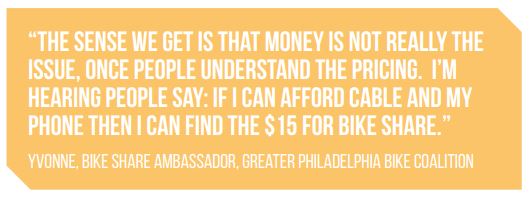NACTO Bike Share | Equity Practitioners’ Paper #2
This paper explores the impact of bike share pricing structures on sign-up rates, particularly in low-income communities. Using research from comparable industries, findings from focus groups, and reports from outreach ambassadors, NACTO found that adding monthly membership options to bike share pricing plans may increase bike share enrollment, especially among low-income potential riders. In particular, the analysis identified that low-income people may especially benefit from installment options or monthly memberships.

Distilled into seven takeaways for other cities, the report lays out the following lessons to encourage bike share enrollment in low-income communities, developed by cities for cities:
» Allow people to spread out costs: Membership plans that allow for installment payments tend to see higher use and better annual retention rates than lump-sum annual memberships. Data suggests that, especially for low-income people, monthly memberships can decrease unease about bike share and increase sign-ups.
» Sticker price is more important than cost: Deep discounts on annual memberships rarely attract significant numbers of low-income people and may tie up money that can be used for other equity initiatives. Expressing full-fare prices in monthly installments may help reduce sticker shock. 
» Keep equity initiatives simple: Adding complicated steps will reduce enrollment. Boston has the highest rate of discount membership sales of all U.S. systems, partially because Hubway’s administrators keep the subsidized membership process as simple as possible – a phone call with honor-system reporting on income or status.
» Make it easy to join: In order to increase ridership, especially among low-income populations, make it easy to sign up for bike share. Cities and operators should look toward technology that facilitates spontaneous enrollment, such as being able to buy monthly or annual access at the kiosk, when potential members are initially thinking about bike share.
» Measure your impact: Gather before/after data to make sure programs are having the right impact. Key metrics to consider including are: average number of rides per user by membership type, rides per bike per day, and rides from stations in low-income areas.
» The kiosk is an opportunity: Especially for potential low-income riders, the physical bike share infrastructure – kiosk and bikes – is the best platform for conveying information about bike share, such as discount programs and pricing information.
» Pricing alone is not enough: Operators looking to increase low-income ridership should ensure that low-income areas have a sufficient number of stations, densely placed, to make bike share convenient and accessible.
Download Paper (PDF) >
NACTO’s Bike Share and Shared Micromobility Initiative >
Can Monthly Passes Improve Bike Share Equity? is the second in NACTO’s Equity Practitioners’ Paper series, which highlights best practices for cities aiming to address equity issues while introducing or expanding their bike share systems.
Read the rest of the Equity Practitioners’ Paper series:
Equity Practitioners’ Paper #1 | Walkable Station Spacing is Key to Successful, Equitable Bike Share
Equity Practitioner’s Paper #3 | Equitable Bike Share Means Building Better Places for People to Ride